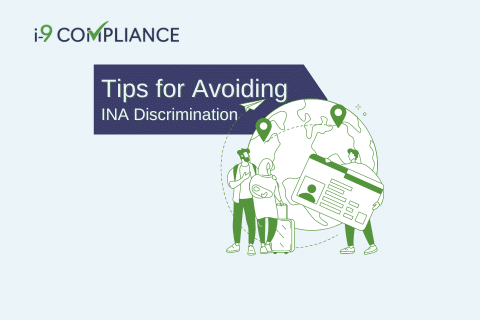Tips for Avoiding INA Discrimination While Complying with Form I-9 and Export Control Requirements

May 23, 2023
The Department of Justice (DOJ) released a new fact sheet in April. This fact sheet clarified how to prevent discrimination in the employment eligibility verification (Form I-9) process. According to the DOJ, this information addresses discrimination prevention under the Immigration and Nationality Act (INA) while complying with export control regulations.
This guidance comes after recent DOJ enforcement actions to avoid potential liability. The DOJ’s fact sheet outlines relevant export control laws and regulations, such as the International Traffic in Arms Regulations (ITAR) and the Export Administration Regulations (EAR). These regulations limit employers’ ability to export certain goods and information, including disclosing such information to “non-U.S. persons.”
For export control, the guidance defines “U.S. persons” as U.S. citizens, U.S. nationals, lawful permanent residents, refugees, and asylees. Sometimes, employers must perform an export compliance assessment before sharing export-controlled information with a worker. This assessment allows the employers to verify the worker’s status as a U.S. person.
Employers must also verify a worker’s citizenship and immigration status, if applicable, when determining whether the worker counts as a U.S. person in the assessment. Workers must receive authorization before handling certain goods if they do not qualify. However, they may receive authorization from the Directorate of Defense Trade Controls or Bureau of Industry and Security for the employer to disclose the information to the worker regardless.
As a result, employers must collect, store, and transfer several forms of information concerning the citizenship and nationality of employees. This requirement can lead to violations of the INA’s anti-discrimination provisions if employers fail to display caution when storing this information.
For example, employers have mixed up the I-9 process with the compliance assessment to their similarities. Like the compliance assessment, the Form I-9 process requires employers to collect and review similar documentation to verify the employee’s authorization to work in the United States. As such, the DOJ’s new fact sheet has explicitly addressed this common issue.
Employers must ensure every hired worker completes Form I-9s, including re-verifications when needed. However, employers must not combine the compliance assessment with the I-9 verification process. Furthermore, employers must remember to conduct compliance assessments only when required under federal regulations.
Form I-9 should never include notes concerning export control verification. For example, Form I-9s do not require information about whether an employee would count as a U.S. person. Meanwhile, employees undergoing an export compliance assessment must clearly state the occurrence and purpose for requesting the documentation.
Finally, employers should not mention specific restrictions in job postings. For example, they cannot cite conditions based on the export control’s limitations regarding citizenship, immigration status, or national origin.
Ensuring compliance with Form I-9 requirements can prove challenging. Companies can avoid violations and ensure uniform compliance with every hire by incorporating I-9 management software into the onboarding process. This tool provides detailed guidance for completing the verification process. It also offers a suite of features, including digital storage of forms and documentation.
When it comes to your employees, automation makes eligibility verification quick and simple. Ensure compliance today with I-9 Compliance.